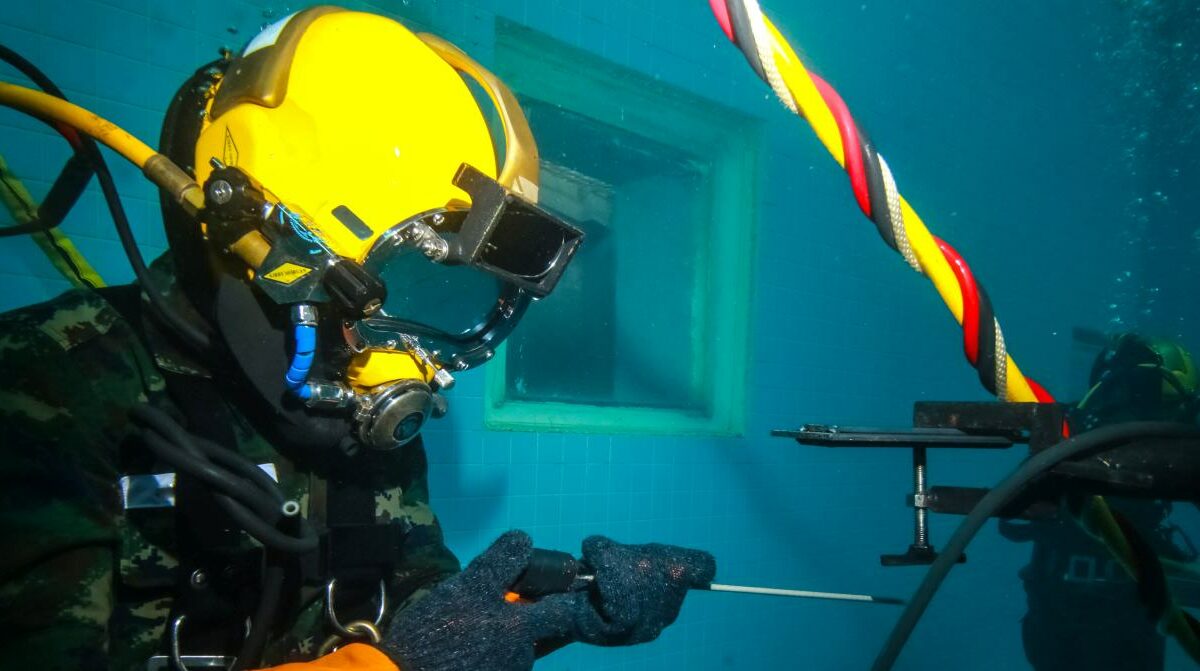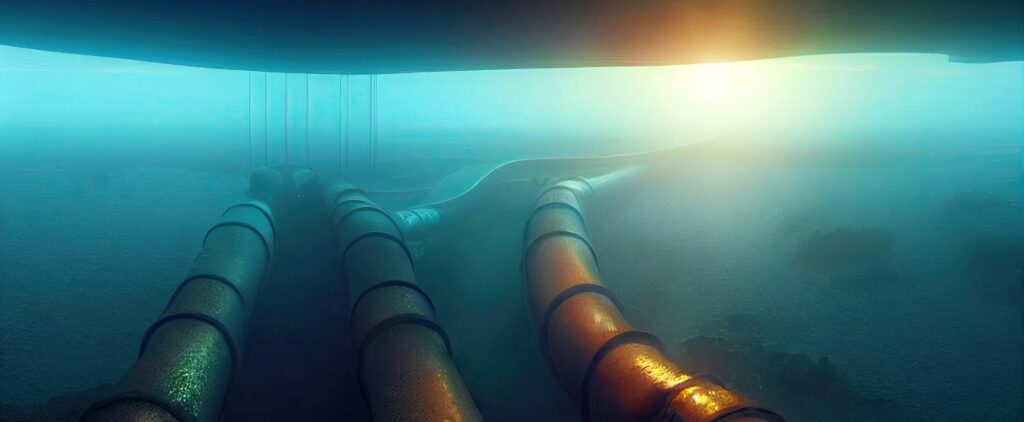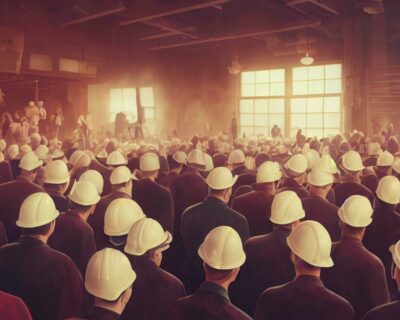
How They Work Safely – A Look at Underwater Welding
If you consider welding on its own, it comes with a fairly long list of risks. The same goes for diving, especially at considerable depths. But with underwater welding, these two activities are combined – meaning it’s a hazardous occupation. It may have a lower than average TRIF (Total Recordable Injury Frequency) rate, but mistakes can often be fatal due to the snowball effect of harsh environments.
Underwater welding combines a powerful electric current with a wet environment. Couple that with the extreme depths and you have a harsh environment. This is why every underwater welder, no matter their level of experience, knows the importance of putting safety first.
Explore this Article
- Hyperbaric Welding vs. Wet Welding
- Why is Underwater Welding So Dangerous?
- Most Common Hazards of Underwater Welding
- How Underwater Welders Stay Safe
- Training is Key to Mitigate Risk While Welding Underwater
Hyperbaric Welding vs. Wet Welding
When people talk about “underwater welding”, they’re referring to one of two methods:
- First, there’s hyperbaric welding – this is the preferred method of underwater welding. This method is used for structural high pressure welds where bolt up flanges aren’t an option. A hyperbaric chamber is installed around the area that’s getting welded, meaning the welder can work in relatively dry conditions. This lowers the chances of cracking due to rapid cooling, resulting in consistently stronger welds. It also reduces the likelihood of electric shock, which is always a risk when you’re mixing electricity and water.
- Second, there’s wet welding. Which is less risky but often produces lower-quality welds, sometimes hyperbaric welding simply isn’t an option. Hyperbaric is only possible if you can put the atmosphere where you’re working. In lots of situations, hyperbaric is not cost-effective. Wet welding uses specialized safety measures to prevent the electric current from passing through the welder, but extra care is needed when using the underwater welding machine; even something as simple as a mishandled electrode can have grave consequences when using this technique. For wet welding, a supervisor is in control of the dead man switch and welders reverse the polarity of the welding leads.
Why is Underwater Welding So Dangerous?
Not only do underwater welders complete rigorous technical and safety training, but they also pay close attention to preparing and executing every underwater welding job; you just never know what could happen. Some of the hazards of underwater welding are predictable, but there are also quite a few variables. These can quickly destabilize the welder’s safety, forcing them to make the best out of a bad situation.
Given how unstable an underwater welder’s work environment can be, most of the dangers actually come from the “underwater” aspect of the job, more than the “welding” aspect. For example, the risk of drowning or decompression sickness is much higher than the risk of electrocution or burns.

Most Common Hazards of Underwater Welding
It’s no surprise that underwater welding comes with plenty of risks. Drowning is among the most common, but there are several other hazards that underwater welders have to watch out for.
- Marine life – Sharks would be the most obvious dangerous species of marine life that underwater welders would encounter, but they aren’t the only issue, nor are they the most prevalent. Sharks tend to leave divers alone. Underwater welders have a bigger chance of being pricked by poisonous sea urchins. The light from the welding arc can also attract other “harmless” fish, which can interfere with visibility.
- Gas buildup – Depending on the structure that’s being welded underwater, there could be a spot where bubbles of hydrogen and oxygen collect. Since these gasses are explosive, if enough of them have accumulated, a single stray spark could set them off. However this is more of an issue for cutting via torch (broco cutting) rather than welding.
- Hypothermia – Deep-sea welding is done in very cold temperatures, so hypothermia is a real risk for any welder that stays underwater for too long.
- Electrocution – Water is an extremely efficient medium for conducting electricity, and wet welding involves plenty of water. Hyperbaric welding is less risky in this regard, but it’s still important to stay observant while using welding equipment in any underwater environment.
- Decompression sickness – Also known as “the bends”, this is what happens when changes in pressure during the ascent results in the accumulation of dissolved gasses within certain parts of the body. Most cases are fairly mild, but advanced decompression sickness can be life-threatening.
- Drowning – This usually happens due to equipment malfunction. A mask could start leaking, or a hose could get ripped or twisted. Sometimes there are backup strategies available (such as an emergency oxygen tank), but they aren’t always enough to prevent a drowning fatality. Sometimes divers—whether using a full-face helmet or other equipment—simple get stuck in a situation where rescue is limited. This depletes air supply and tragedies ensue.
How Underwater Welders Stay Safe
Just like the risks of underwater welding are totally different from the risks of regular welding, the safety training and required skills are different too. Let’s go back over the list of hazards above, and examine what underwater welders do to address them.
- Marine life – There isn’t much the welder can do to ward off fish or sharks once the job has started, but they can prepare precautions depending on the marine life. During the dive plan phase, divers will change procedures depending on the frequency of marine life contact. If new dangerous marine life shows up while the job is being carried out then the diver may be removed and a new dive plan will be planned.
- Gas buildup – If there’s any chance that hydrogen or oxygen could accumulate, it’s crucial to ensure that areas that would allow gas buildup are properly vented. This could mean installing a vent tube, or cutting holes above to allow the gasses to escape.
- Hypothermia – Deep-sea welding requires insulated scuba equipment, but miniscule tears in gloves or suits could let moisture in anyway. Before going underwater, welders should thoroughly inspect their scuba equipment to ensure that everything’s still water-tight.
- Electrocution – There are a number of precautions to observe in order to prevent electrocution. For example, the underwater welding machine must use DC (Direct Current), not AC (Alternating Current). Every surface that could possibly conduct electricity – including the welder’s body – should be insulated in rubber. Underwater welding also uses special waterproofed and insulated electrodes; the welder has to avoid setting the electrode down quickly, as this can turn their own body into a conduit that accidentally grounds the charge.
- Decompression sickness – The most important mistake to avoid is ascending too quickly after a deep-sea welding job. This can occur if the underwater welder exceeds 33 feet per minute. That isn’t all, though; welders also have to limit the length of their deep-sea dives, avoid alcohol and dehydration, and give themselves time to adjust between deep-sea dives and plane flights.
- Drowning – If an underwater welder finds that their primary air supply has been cut off, the first thing they need to do is avoid panicking. They should still be able to communicate with team members or leaders, so a level-headed response must be maintained until help arrives. They could also troubleshoot to find other solutions, such as switching to their emergency oxygen tank, fixing a broken connection on their helmet, or any other option that presents itself.
Training is Key to Mitigate Risk While Welding Underwater
Underwater welding requires strict attention at all times, from putting on the scuba suit to making the ascent. It’s a smart idea to use caution with any job, but in this case, the consequences of carelessness can be much more serious.
The good news is, many of the hazards associated with underwater welding can be mitigated with the right safety measures. This isn’t the type of job that people apply for on a whim; it requires years of training to earn specialized certifications, as well as continued safety training to keep them focused and up-to-date. Whether it’s from education or personal experience, every underwater welder knows the importance of following procedure to stay safe on the job.


























